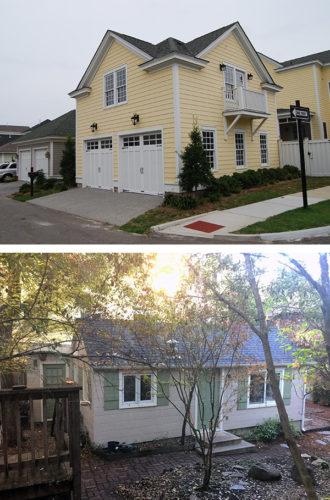As we’ve highlighted over at missingmiddlehousing.com, carriage houses are an important type of Missing Middle Housing. They exist across the country, and like a lot of Missing Middle Housing types, they were built extensively before 1940 but haven’t been produced much in the last 50 – 75 years, in large part due to their obstruction by archaic zoning codes. Recently, however, we’ve seen a number of regulations changing to allow these types and, consequently, an uptick in the number of carriage houses being built.
So, What Exactly is a Carriage House?
A carriage house is a secondary structure, typically located at the rear of a lot, providing space for a small residential unit, home office, or other small commercial or service use. This unit could be above a garage or at ground level. Carriage houses are unique in that they complement other buildings exclusively. They can be add-ons to multiple-unit buildings or single-family homes.
One way to think of carriage houses is that they are a step between a house addition and a separate condominium or similar dwelling. Carriage houses can’t be bought or sold by themselves, but they’re more than just an additional bedroom or wing because they’re intended to provide users with autonomy and privacy.

“But wait!” some may say. “Isn’t that simply an Accessory Dwelling Unit?” The short answer is yes, it is. What we call a carriage house is more or less synonymous with an Accessory Dwelling Unit (ADU), but we prefer the carriage house terminology for the character it connotes: a non-technical term like carriage house has a quaint sense of tradition to it, unlike the more technocratic and hard-to-understand “ADU.” Other terms we’ve seen used to describe carriage houses include granny flats, in-law suites, and garage apartments, to name a few.
Recently, as the demand for walkable living options continues to rise, carriage houses have been catching on. Zoning codes prohibiting them have seen reform, and more and more units are popping up. Notably, Austin, Texas has recently legalized these types. In California, Governor Jerry Brown recently signed into law a bill easing restrictions on carriage houses, and similar regulation busting has taken place at the local level, in Oakland and Berkeley. In Oregon, trailblazing regulatory reform and the right market conditions have led to a thriving carriage house developer community, with a cavalcade of successful projects coming online of late.
The Benefits of Carriage Houses
So, what benefits come from having or building a carriage house? For one, carriage houses come with the ability to house family members, which can be a welcome option for empty nesters looking to move back in with the kids, either for health, economic or other reasons. They can also be an option for young families looking for long-term housing but not yet in a position to buy. In both cases, carriage houses are a clear option for families looking to live multigenerationally but not wanting to get too crowded under one roof.
This same benefit applies even if the families aren’t related to the homeowner. Carriage houses can provide housing for seniors who want to “age in place” in their community but don’t want to care for a single-family home. These units can also be appealing to single women, young adults just starting out, and even small families—all groups that may not want, need or can’t afford a detached single-family home.
Also, thanks to the rise of short-term rental services, these units can be sources of income for homeowners. While we understand short-term rentals are often fraught with debate, we generally think they are a good thing if the owner is living on the lot, since renting out carriage houses can help homeowners lower their housing costs, thus increasing standard of living.
In addition to the individual benefits of carriage houses, there is also the bigger picture item that’s familiar to all fans of Missing Middle Housing: thoughtfully offering a means to create Smart Growth, while not building outside the scale of our beloved and often character-rich existing neighborhoods. So, while homeowners who add a carriage house can enjoy their individual perks, they can also rest easy knowing they may be positively contributing to overcoming societal dilemmas facing us today.
With the demand for walkable living on the rise, soaring home prices, and “community as amenity” here to stay, there is opportunity now for the carriage house to become an even more vital part of our neighborhoods.